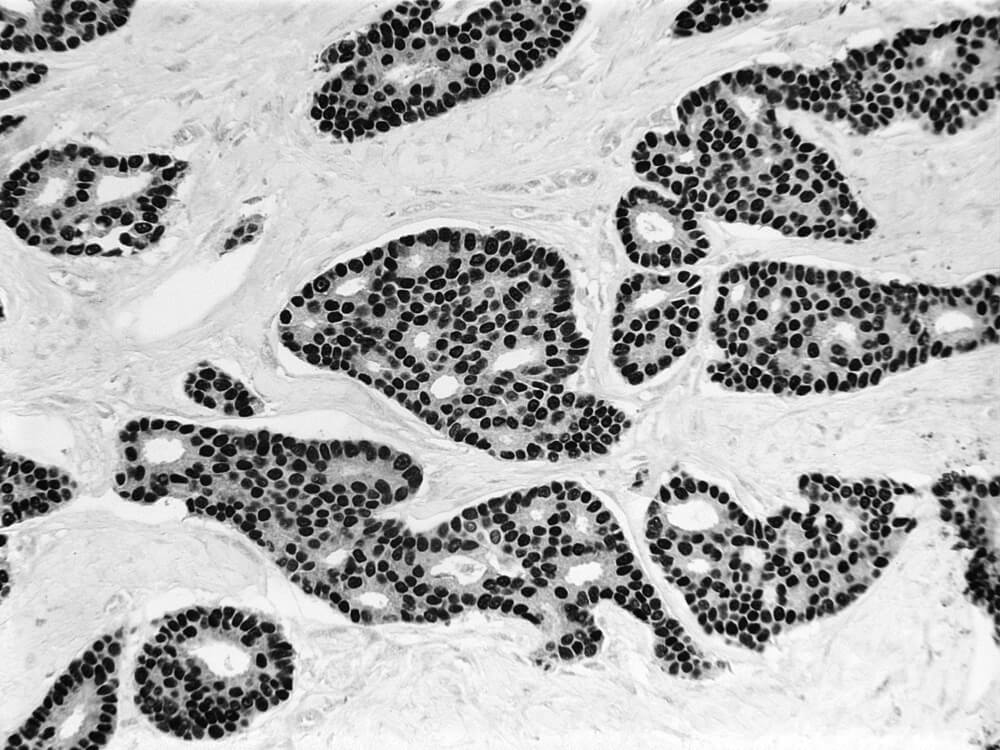When cancer spreads in the body, it is first and foremost due to changes, or mutations, in the DNA of cells. Because of a mutation or other abnormality in a cancer cell’s genome (the DNA stored in its nucleus), the cell may become separated from its neighbors and invade surrounding tissue. Other genomic breakdowns allow the cell to make its way to a nearby blood or lymph vessel, pass through the vessel wall, and ride to another part of the body, where it once again crosses the vessel wall and begins to grow and divide, forming a “secondary” tumor, or metastasis.
The genes that enable tumor cells to break free of their original location and travel to distant sites are part of every cell’s natural endowment. They play a critical role in the early stages of life, allowing cells to move to their assigned positions in the developing embryo or fetus. Eventually, these genes shut down, rendering the cell immobile and helping bind them to their native tissue—be it the lungs, nerves, muscles, or any of the hundreds of other tissue types in the human body. When a mutation or other genetic problem causes the genes to reactivate, tumor cells can gain the ability to move and slip through the spaces between other cells.

Even when cancer cells do break free, their ability to metastasize to other parts of the body is not guaranteed. For one, they may be subject to attack and destruction by elements of the immune system. For another, it takes a variety of genetic alterations to equip tumor cells with the skills needed to pull up stakes and survive in distant tissue: to become unanchored from their home tissue, invade and traverse adjacent tissue, pierce the wall of a blood or lymph vessel, survive a trip in the bloodstream or lymph, make landing downstream, root themselves in a new location, attract blood vessels to draw nourishment, and abide among unfamiliar cells.
Few cancer cells possess all these abilities; most die during their journey through the body. Even when they succeed in settling at a new site, they often remain inactive for many years before beginning to grow again, if at all.
Because metastatic tumor cells have acquired genetic mutations that enable them to survive beyond their place of origin, they may differ, at a molecular level, from cells in the primary tumor. As a result, they may be less vulnerable to drugs that are effective against the tumor. This is one of the main reasons why metastasized cancers are usually more difficult to treat than primary cancers.
The ability to metastasize illustrates cancer cells’ ability to exploit their genetic equipment and surroundings. Genes normally used during fetal development are subverted to enable tumor cells to take up residence outside the original tumor. Blood and lymphatic vessels that carry nutrients, immune system cells, and other critical agents are appropriated by tumor cells as highways to other parts of the body. Substances that normal cells secrete to gain access to blood vessels are hijacked by tumor cells to feed themselves.
Because metastasis involves cancer cells’ ability to make a home in tissue far from the original tumor, a major branch of cancer research seeks to make other tissues inhospitable to breakaway tumor cells. At Dana-Farber, for example, researchers have identified a compound that can potentially prevent multiple myeloma from metastasizing to the bones in animal models. Other research focuses on arming the immune system to prevent metastasis following cancer surgery.

Would like as much information about your progress with multiple myeloma
Thanks
Judy Bouse
This brief article is one of the most highly informative about useful information that I have read in a long time!
My son received immunotherapy given at. Dana Farber. He, 2 years later is doing well and all scans show no metastasis. Thank you Dana Farber ,Dr Beth. and a great team. God Bless You.
DF is the best…..they have had me in a clinical trial for close to 6 years now, working great, little relapse, boom, fixed it right away. Amazing hospital, Dr Brown and her crew are phenomenal.
And is there anything I can DO or Control, to prevent or slow my ovarian cancer from constantly slipping around from site to site requiring repeated treatment of one sort or another???
Great explanation. It seems that boosting the bodies immune system is the most promising from what this article indicates and from my other readings. Keep up the great work.
Clear and passionate explanation of metastasis of cancer cells. Thank you.
Wonderful explanation. Thank you
Than you for the update. Very informative. My wife is a stage 4 ovarian patient in her 3rd year of treatment…..currently Avastin inhibitor every 3 weeks. What is the current status of immunotherapy trials for this “incurable” cancer??
Great, easy to understand article. I am a colon cancer survivor with Lynch Syndrome. I now see how the mis match repair gene can play a role in this process. Thank you for your research and writing this article.
Thank you DF for spreading hope and providing in-depth research and results of cancer studies that can be understood by the lay person! I was diagnosed with triple negative breast cancer in 2015, with a recurrence in 2017. Fortunately, the lymph nodes were not involved in either!
I look forward to updated triple negative research!